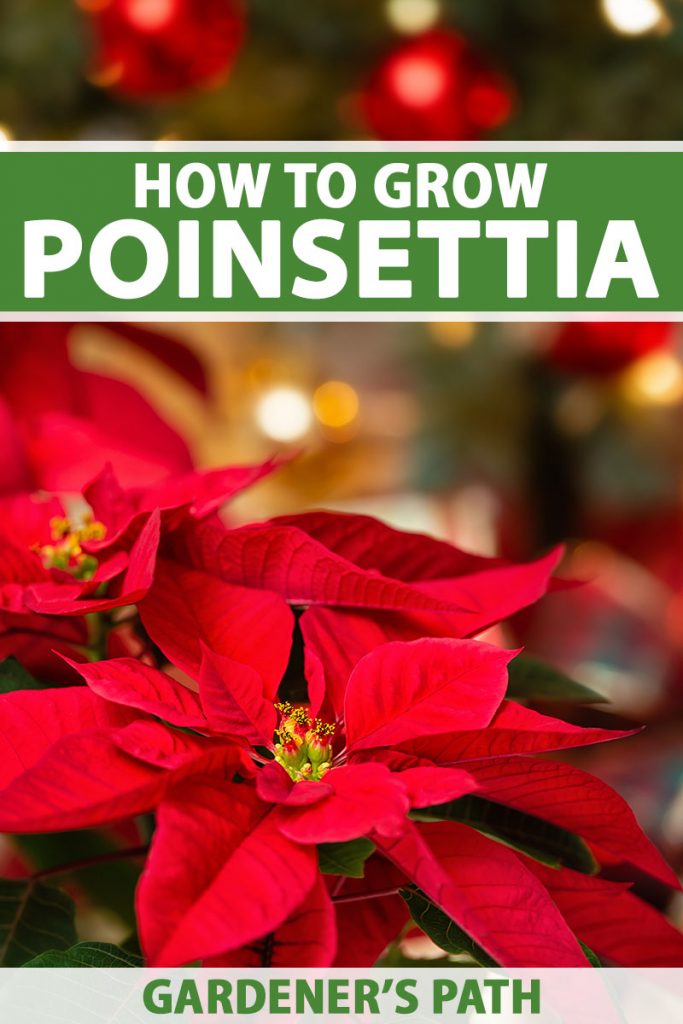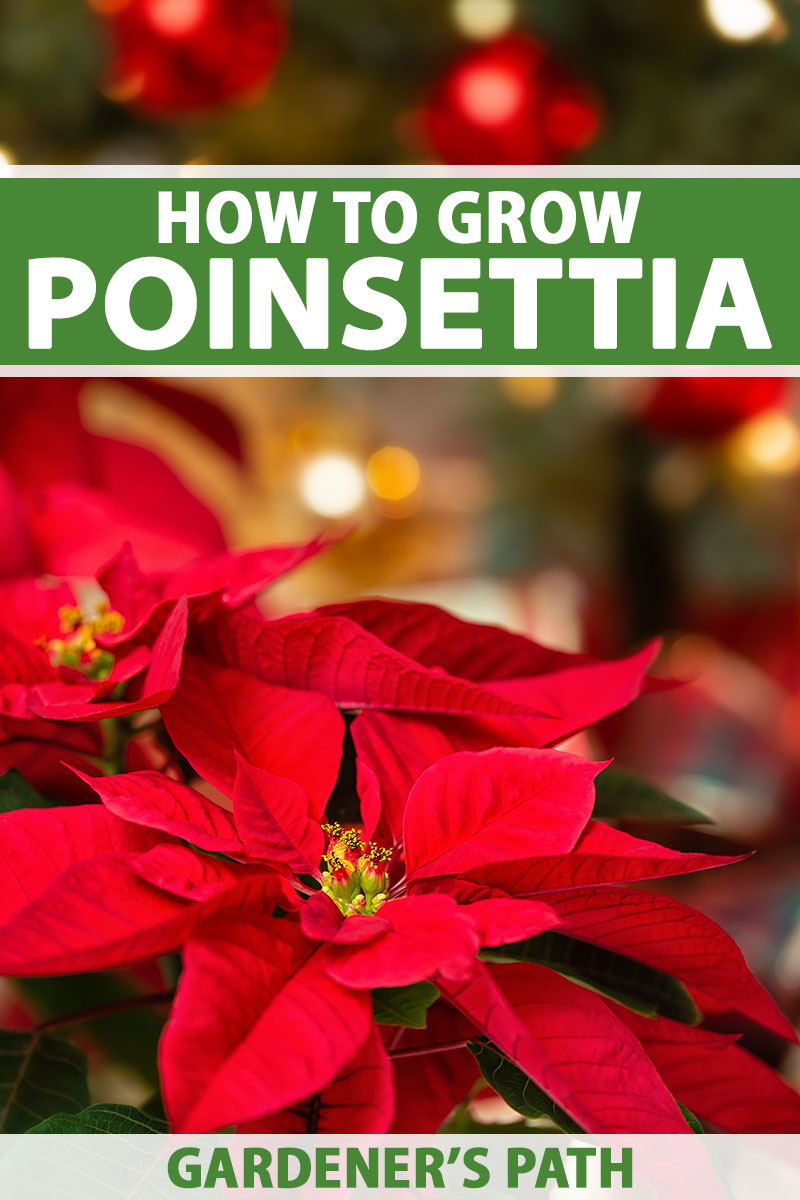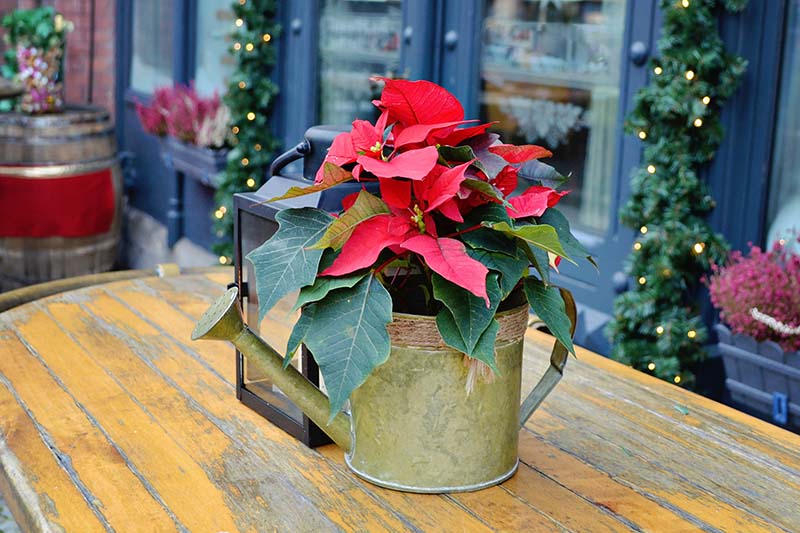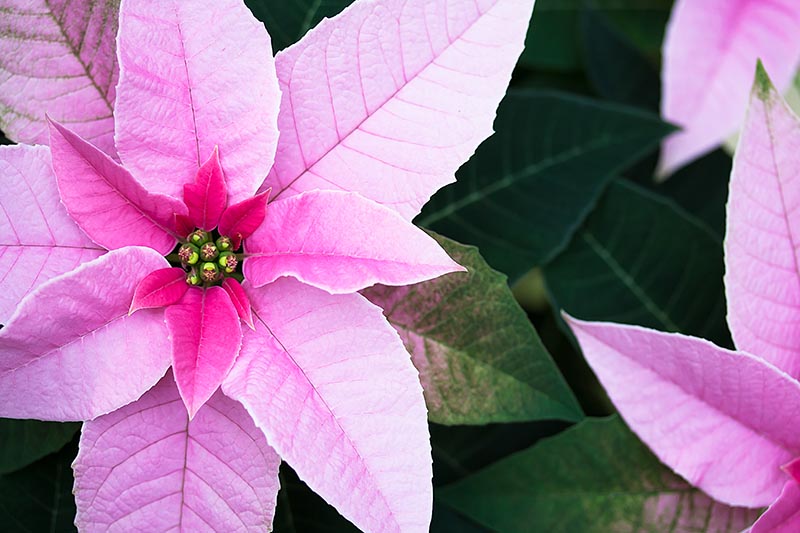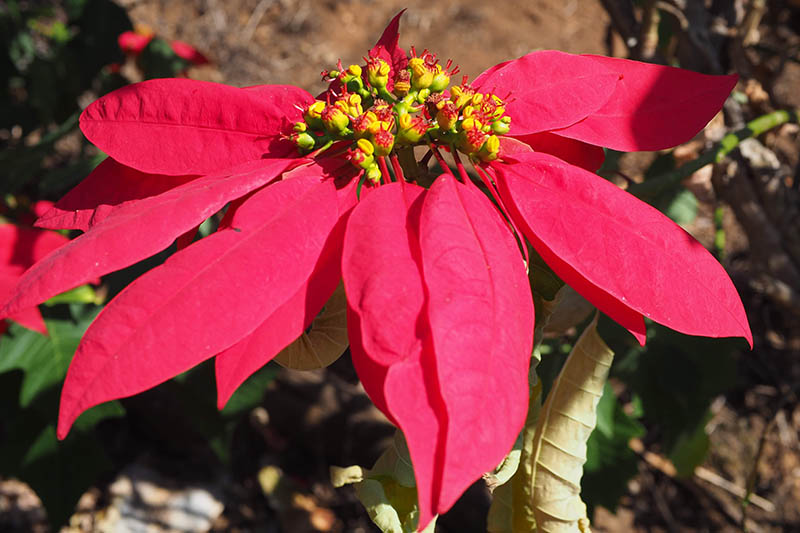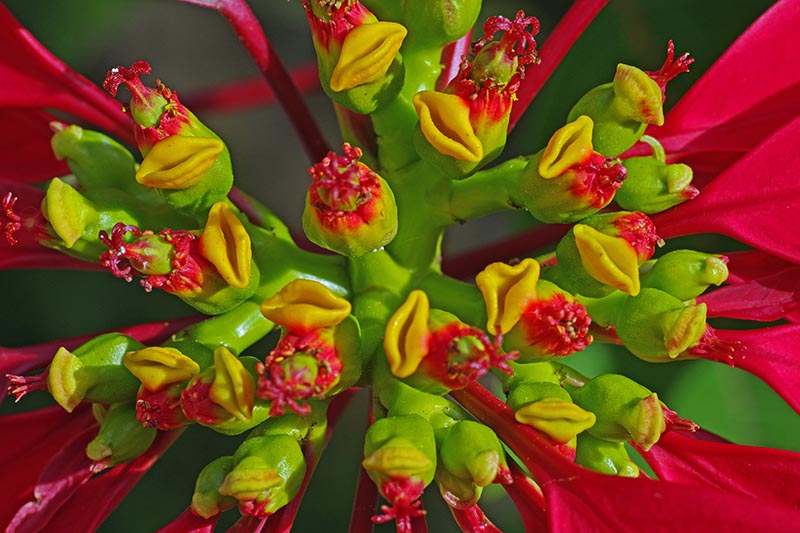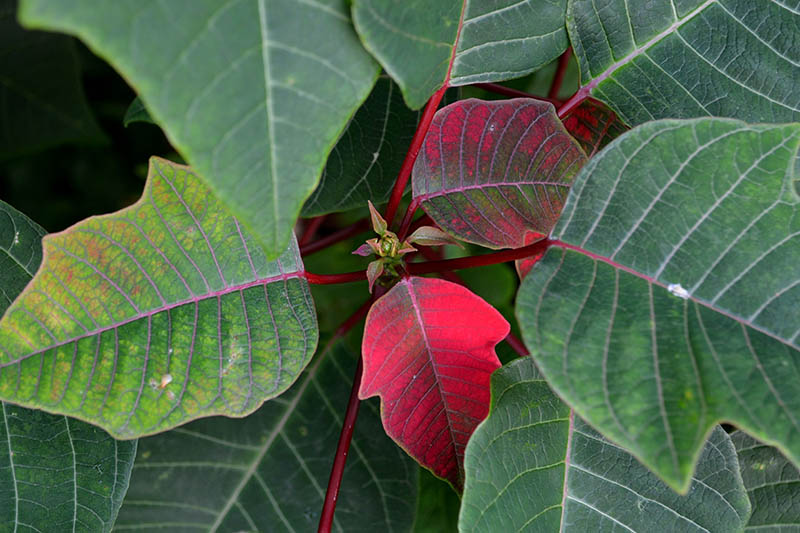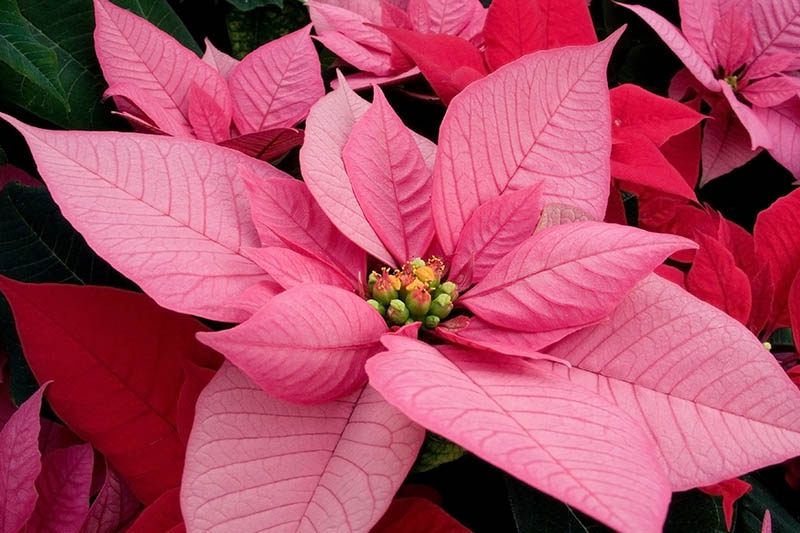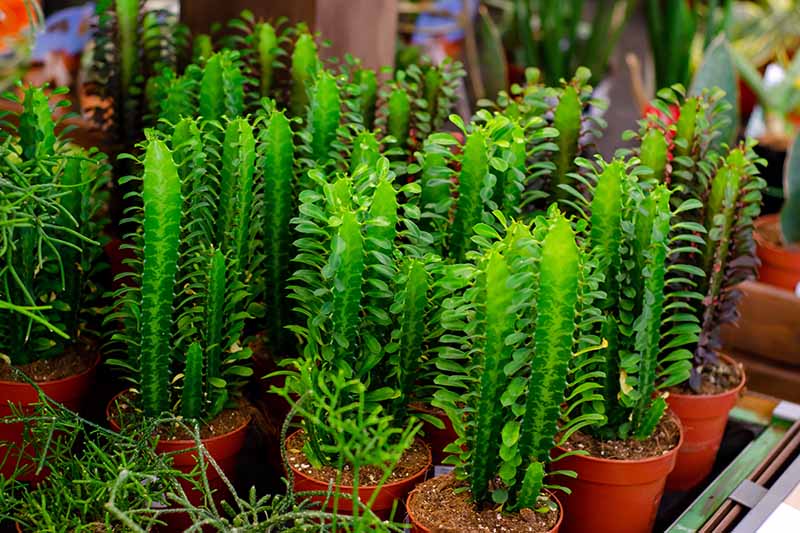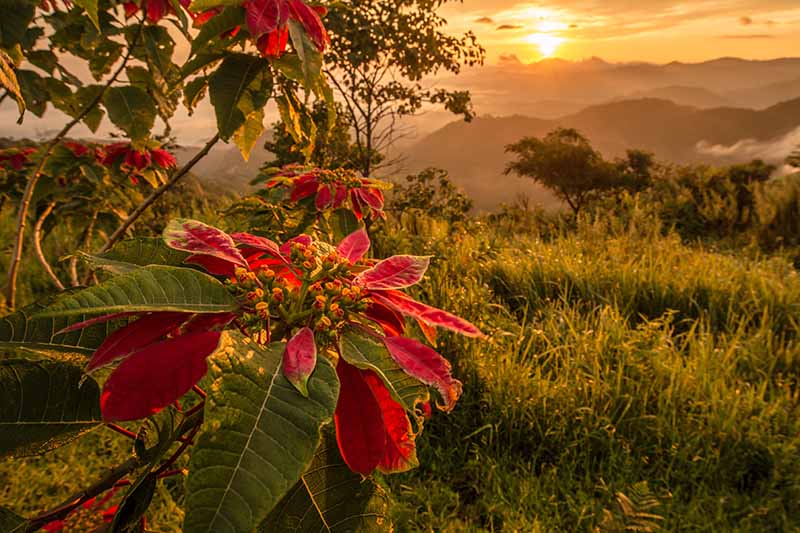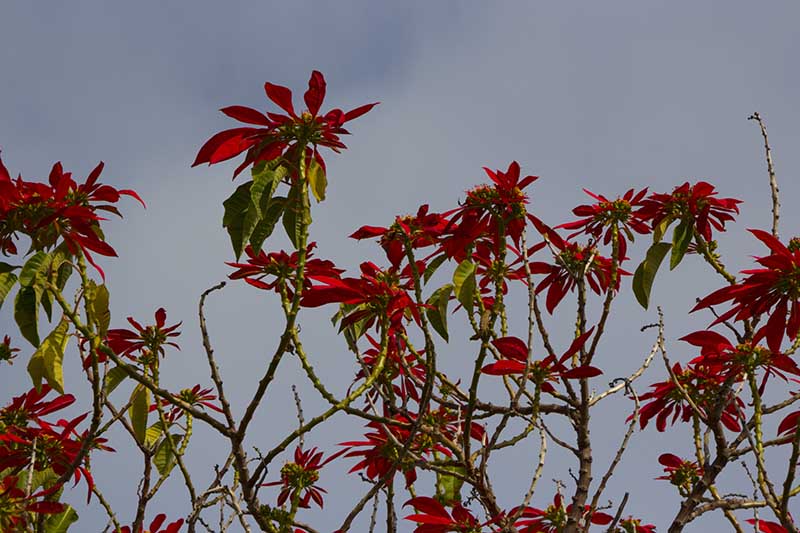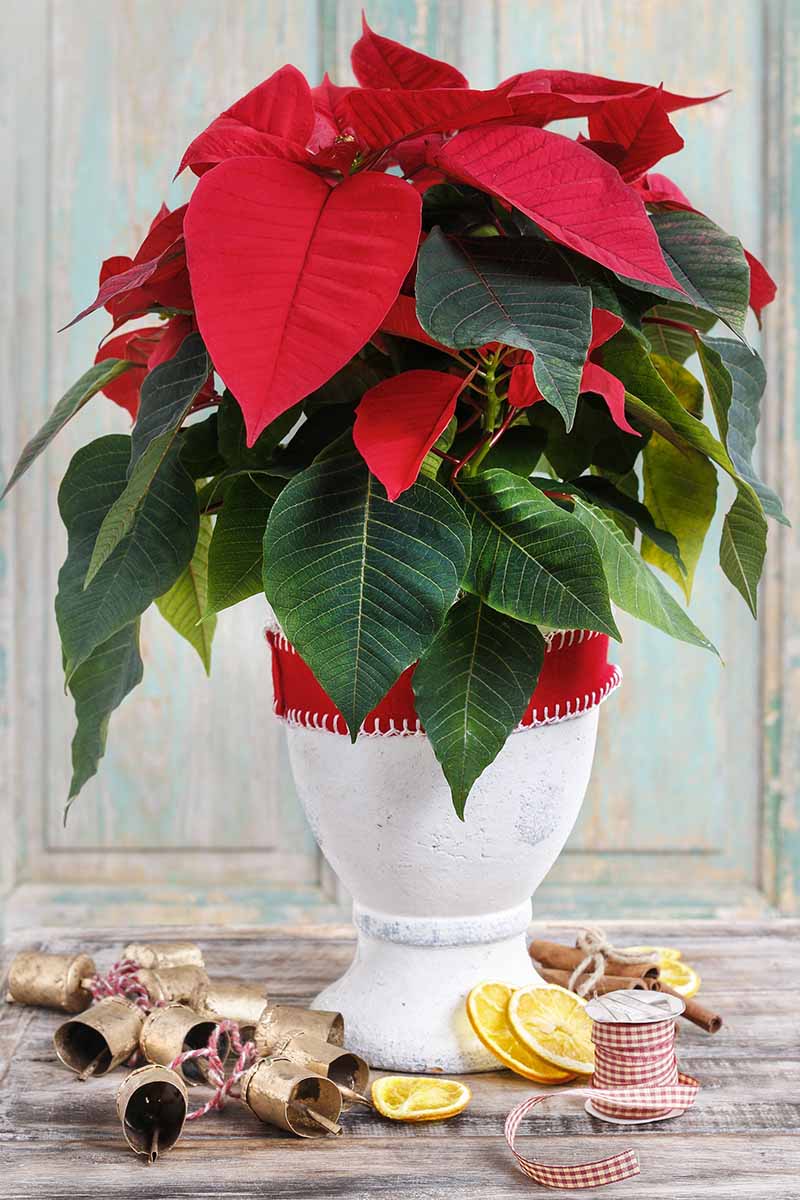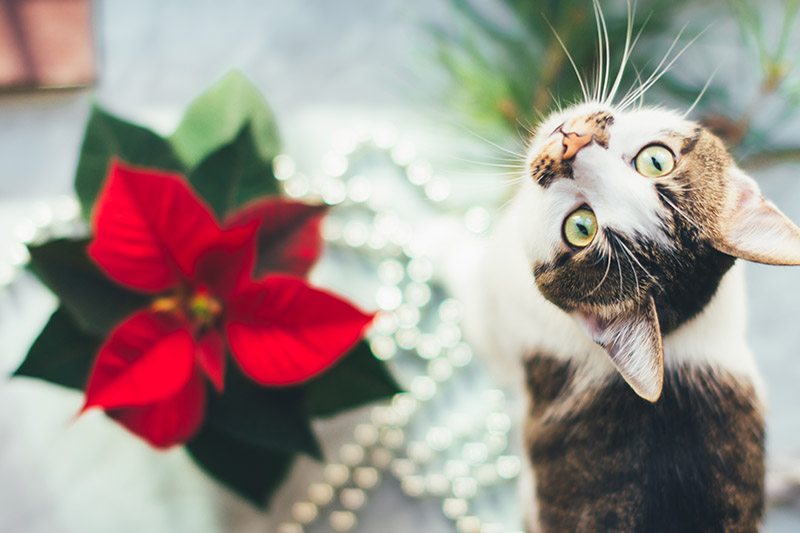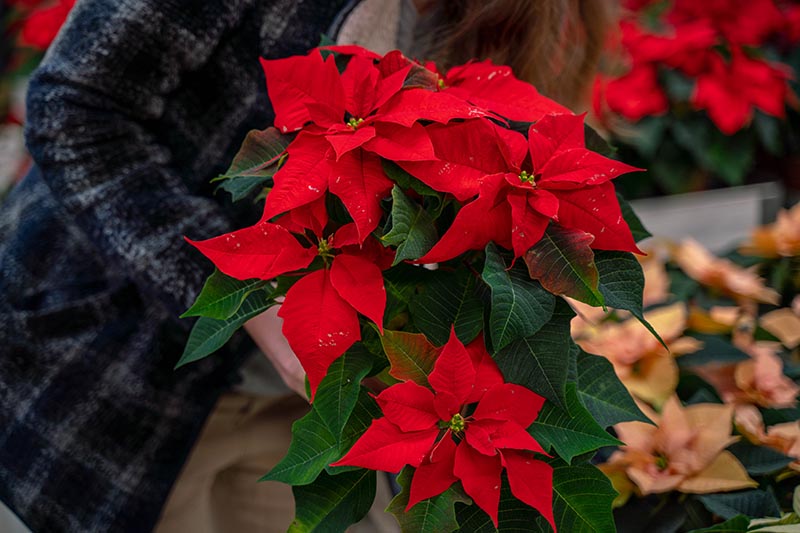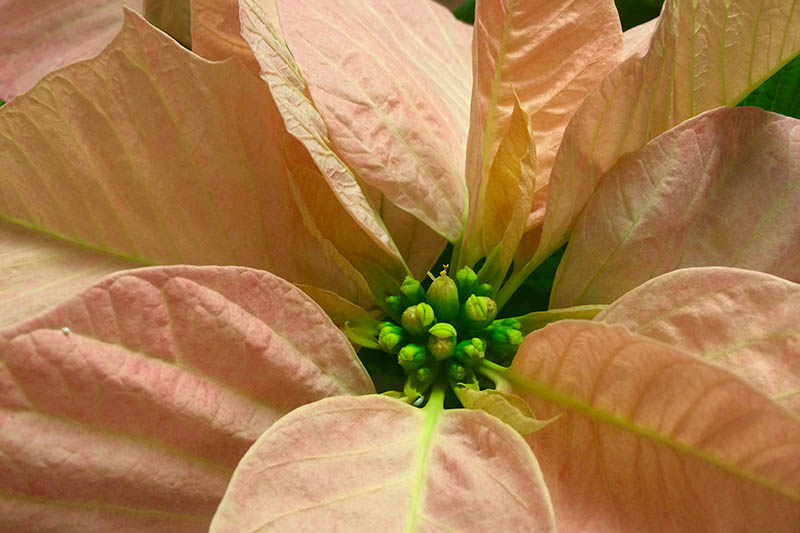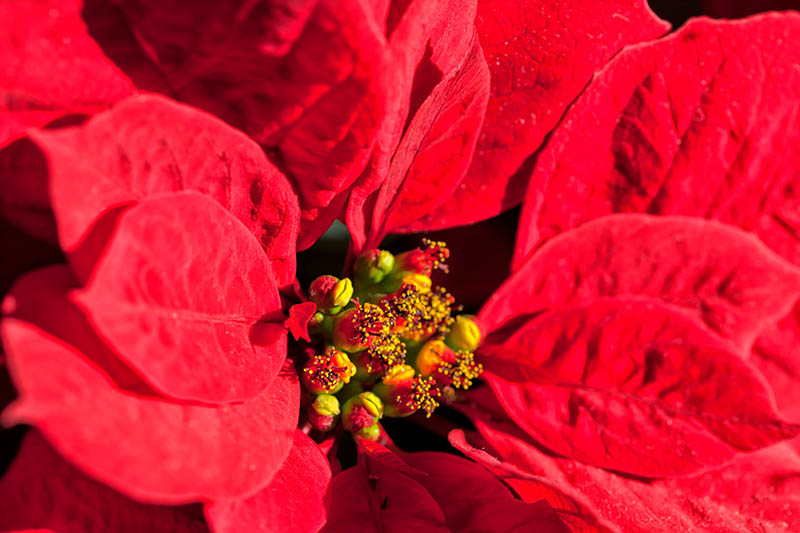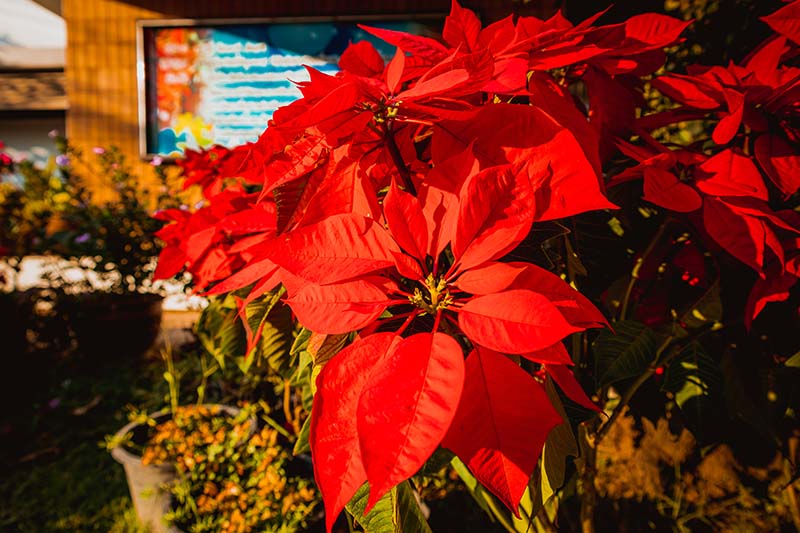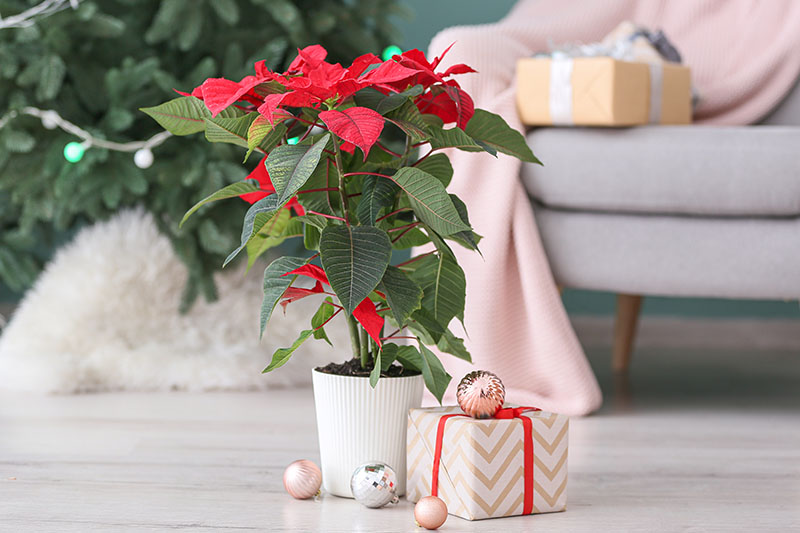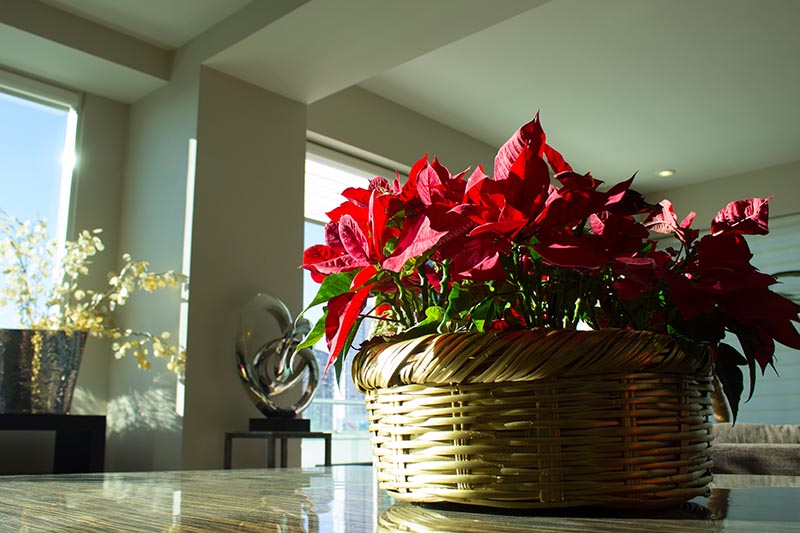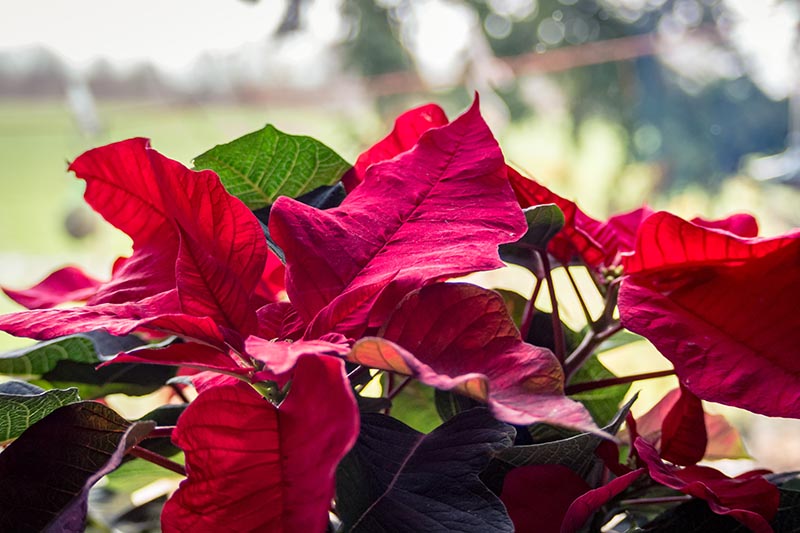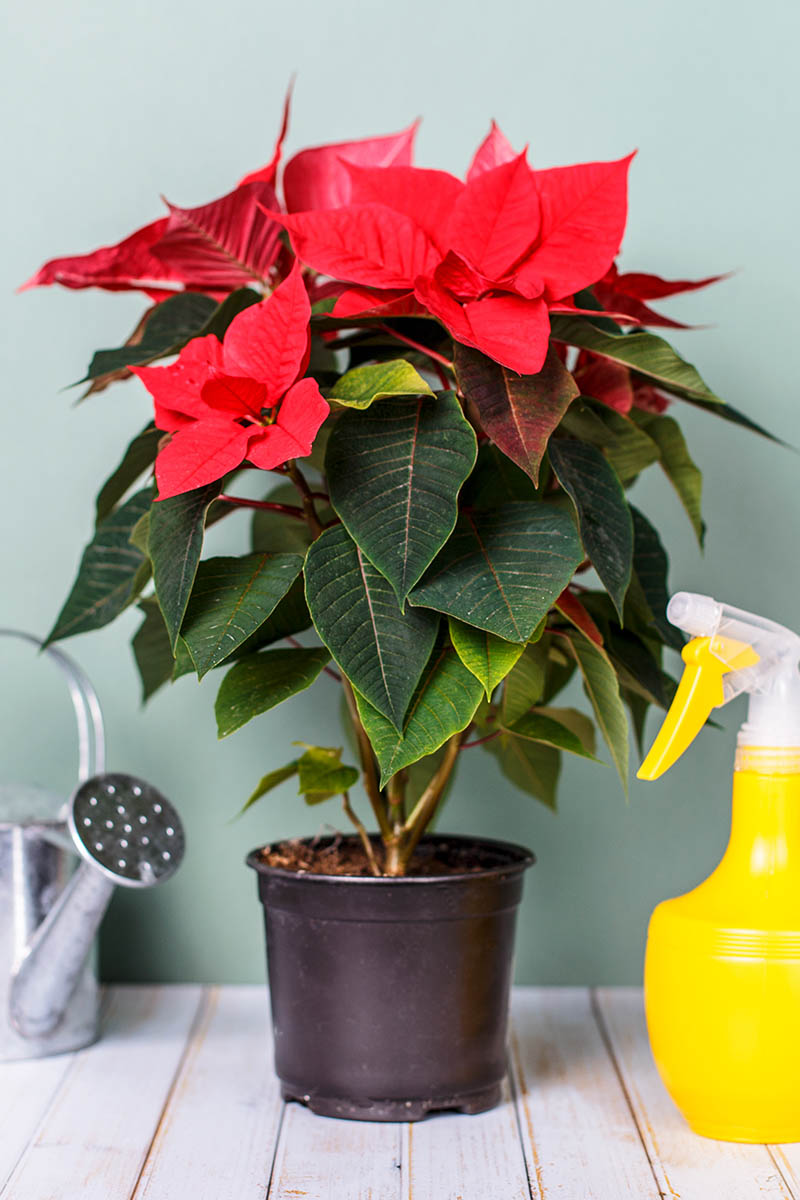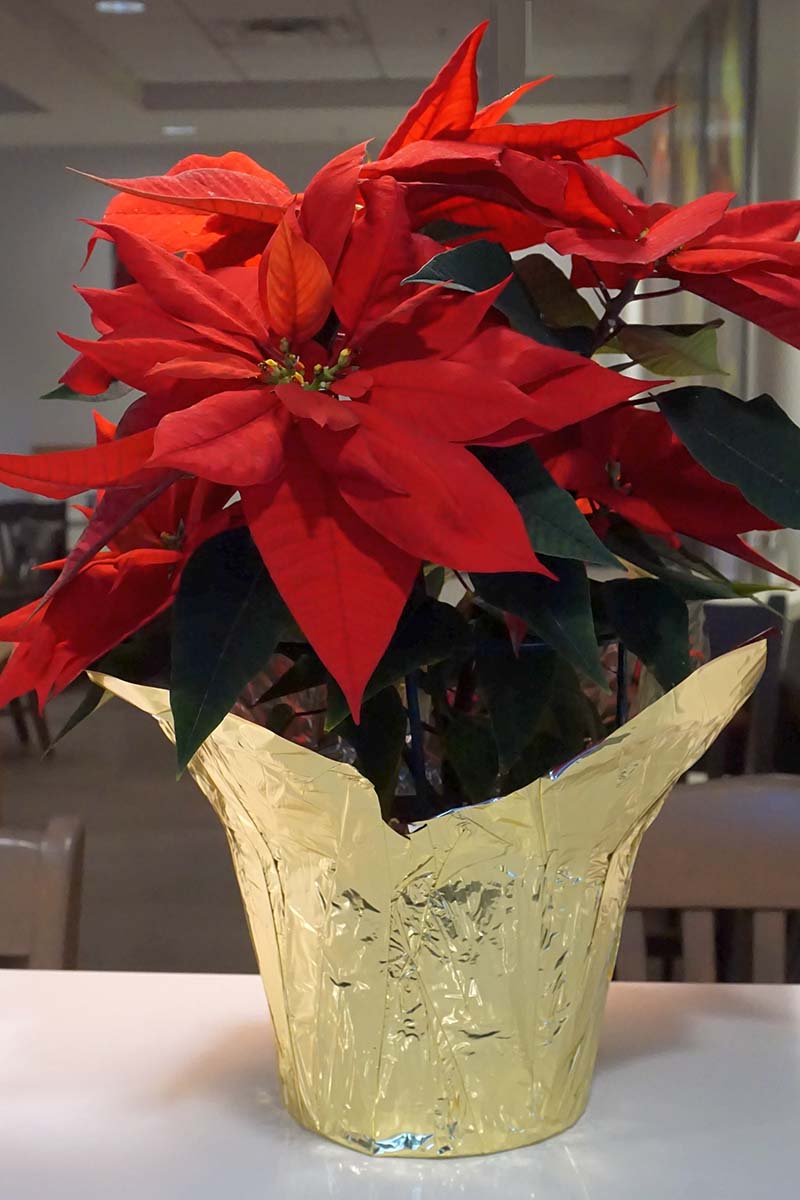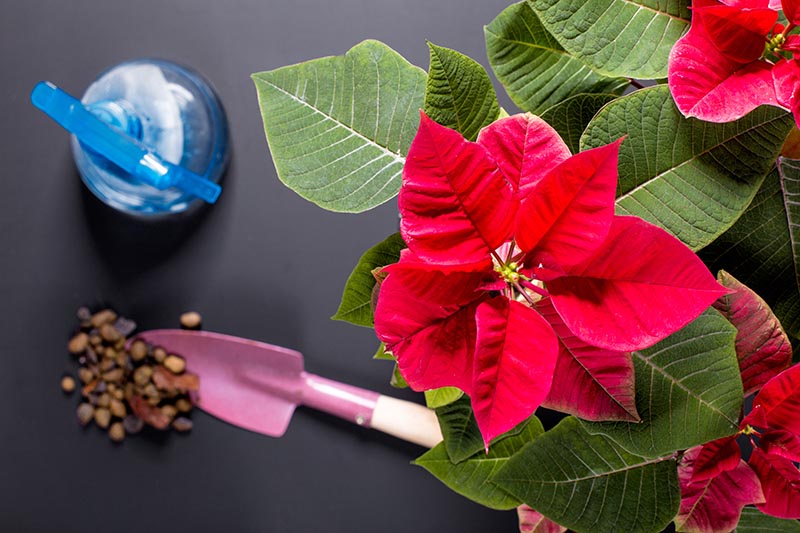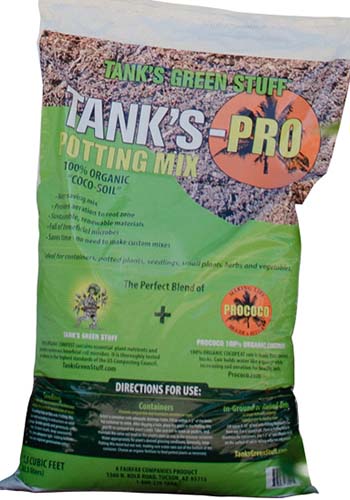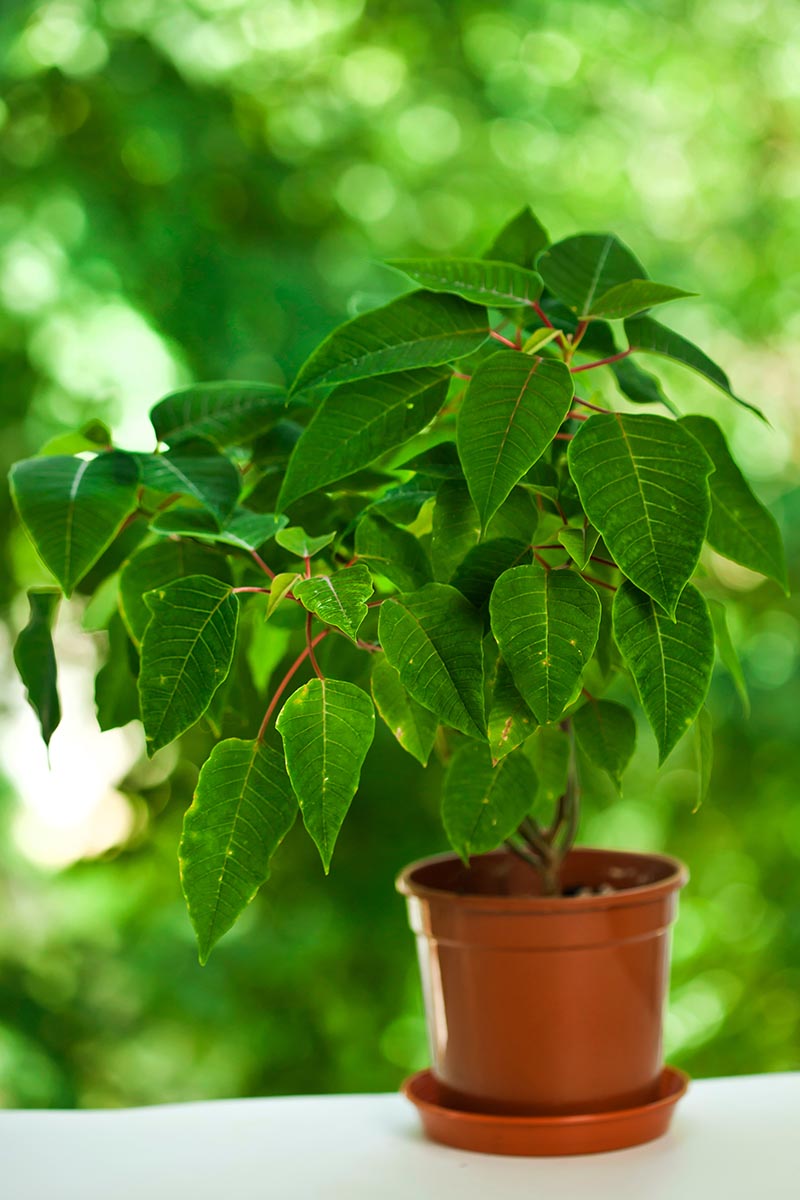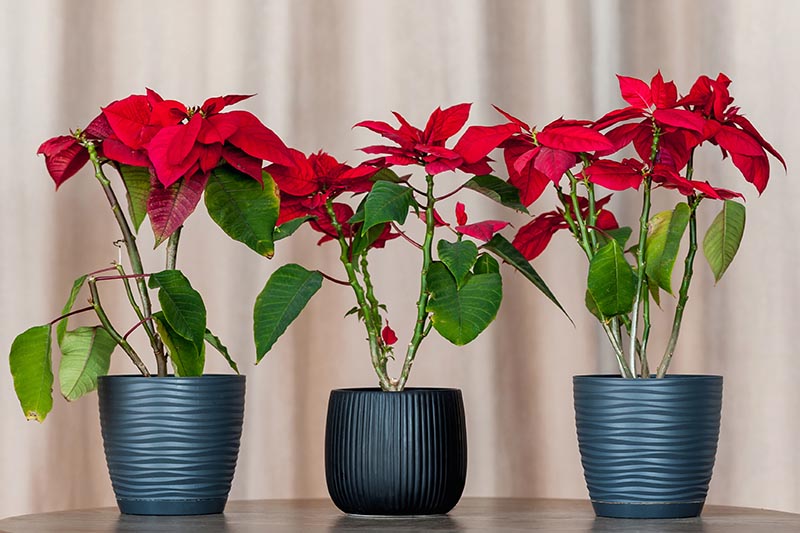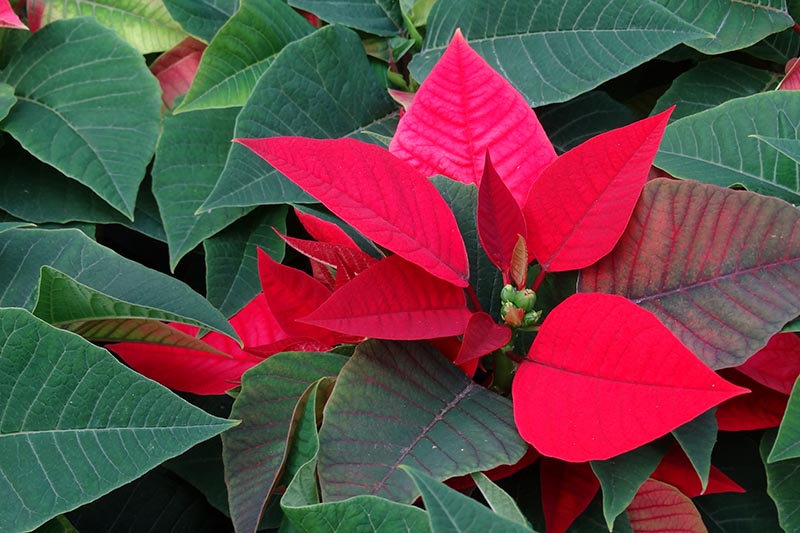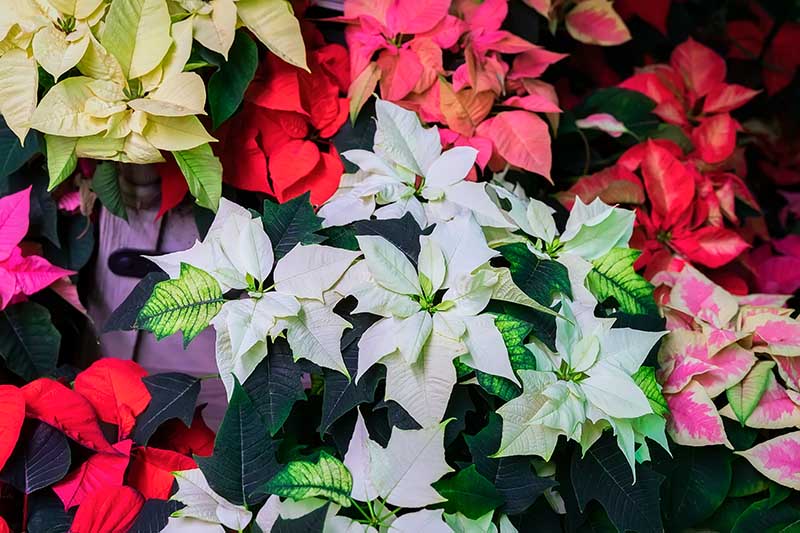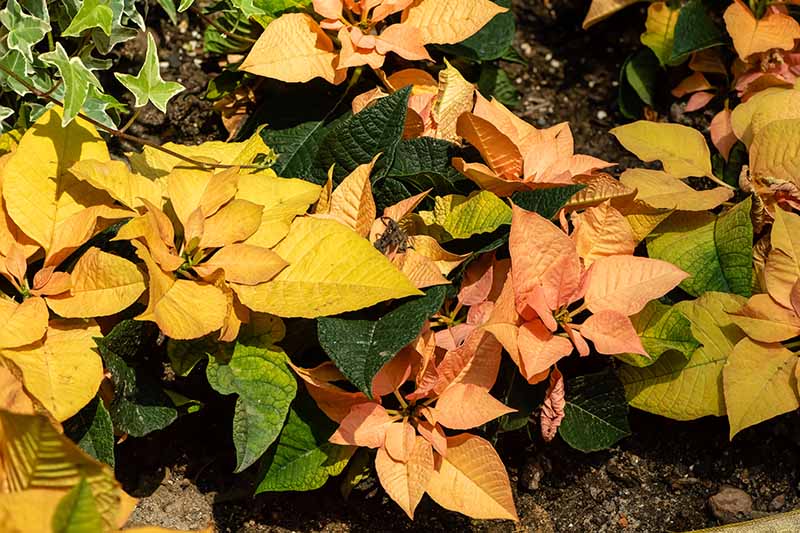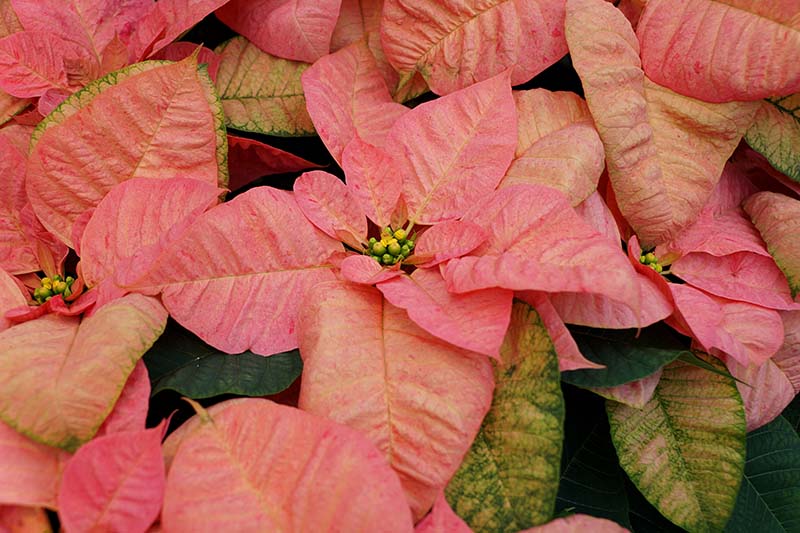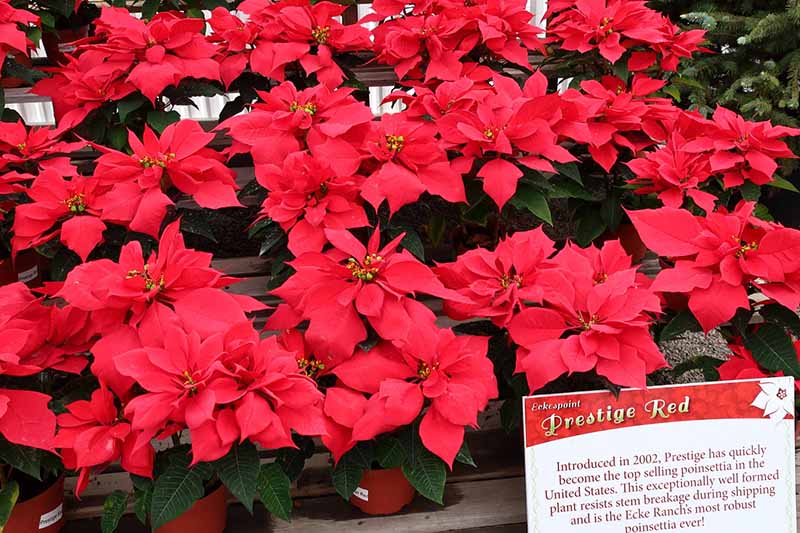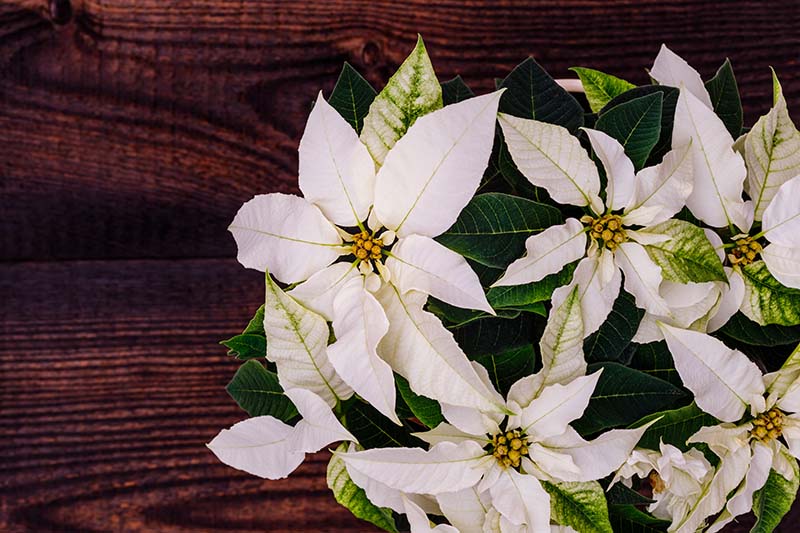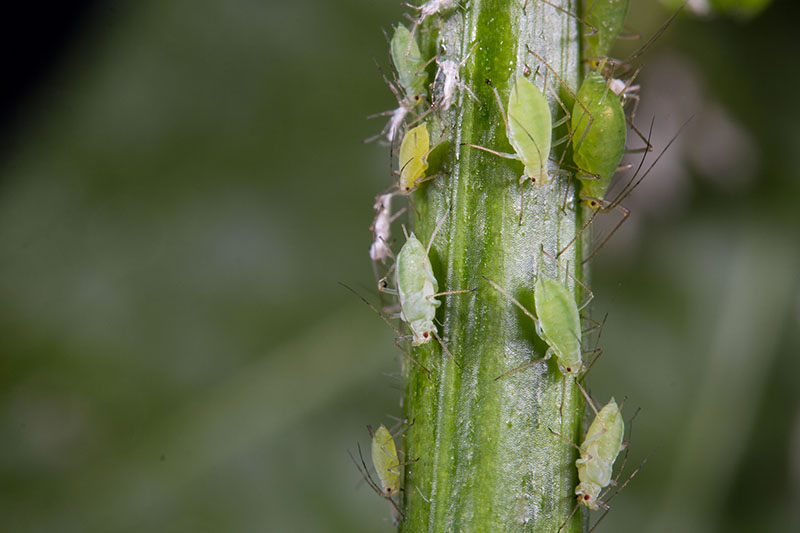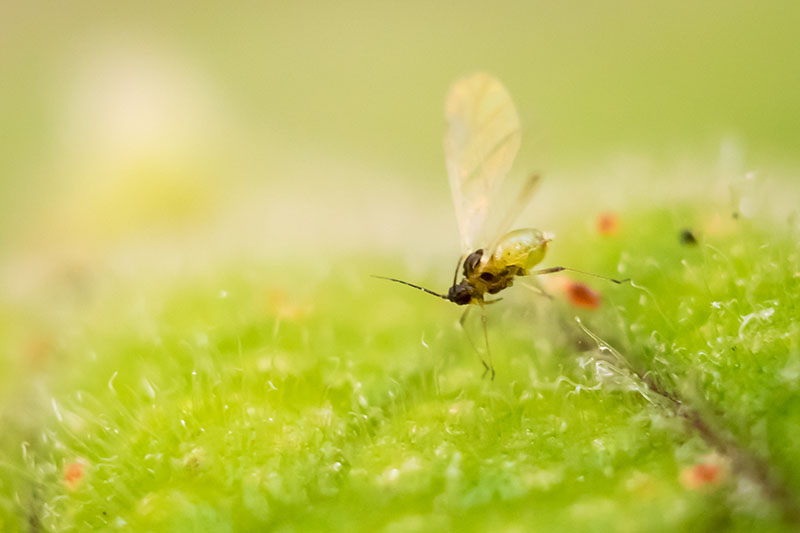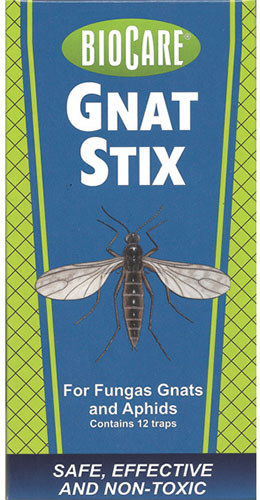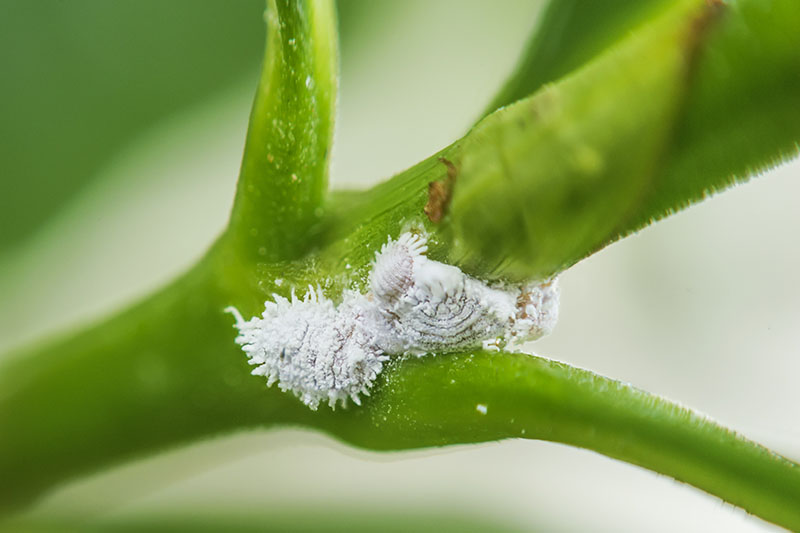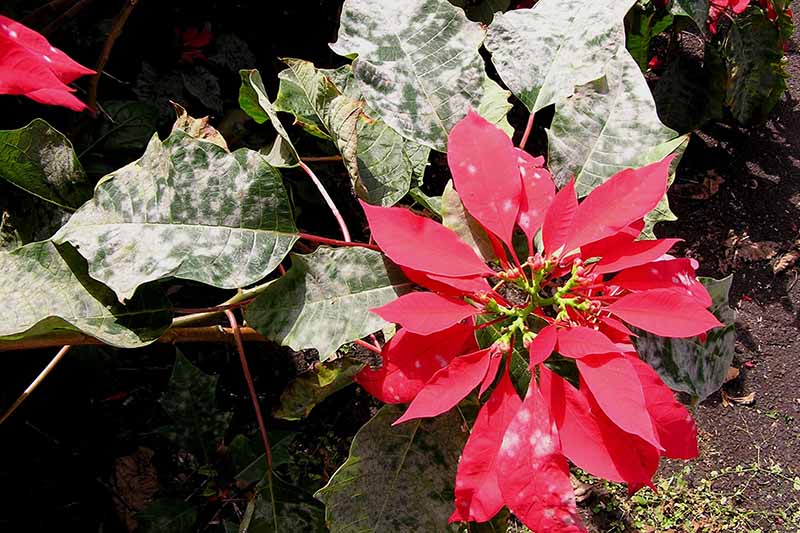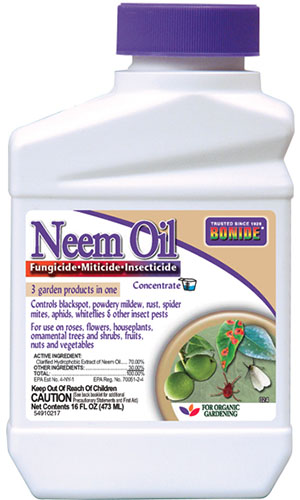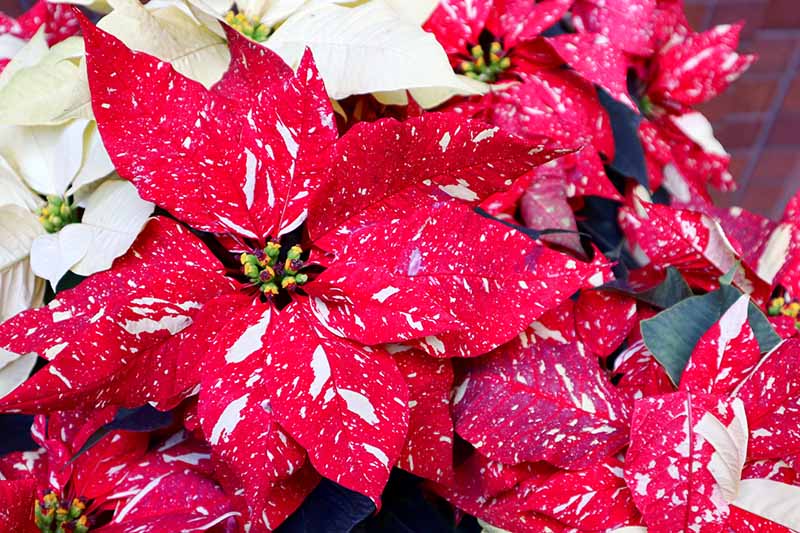I found them to be a bit fussy, and was always worried about breaking their seemingly fragile leaves off the stems while I watered. My feelings of slight resentment towards them changed though, when my boss told me to pick one out to take home – the first poinsettia I would care for as my own. We link to vendors to help you find relevant products. If you buy from one of our links, we may earn a commission. In fact, in some ways, poinsettias are quite resilient. Their strange growth habit, with its period of sparse-looking dormancy, serves as a good reminder that just because things might look bad now, that doesn’t mean a new period of vitality and beauty isn’t just around the corner. Beyond such metaphysical meditations, poinsettias quite literally brighten up the dark winter months spent indoors. Since they start to show off their colors at the same time as the days grow increasingly short and dark in the Northern Hemisphere, they can bring cheer into your life – no matter what you are celebrating at the end of the year.
Poinsettias are probably one of the most colorful plants you can grow indoors, and although we tend to consider them chiefly to be a (perhaps disposable) part of the holiday decor, it’s important to remember that they are alive and need caretaking, just like other houseplants. I’m going to provide you with a guide to caring for your plant, and I’ll tell you about some of the interesting quirks in the poinsettia’s natural history. Here’s what I’ll cover:
What Is a Poinsettia?
Poinsettia, pronounced “poyn-set-ee-uh,” or just as commonly, “poyn-set-uh,” is a popular holiday plant, used in particular to decorate during the Christmas season. You’d probably recognize this winter bloomer, which goes by the scientific name Euphorbia pulcherrima, after just a quick glance – they seem to be just about everywhere during the holidays, after all.
But since they are rather different than the average houseplant, it would be understandable if you misidentified some of the plant’s parts – or misinterpreted some of its habits. So you can choose a healthy specimen and provide it with stellar care, I’m going to start with a brief tour of this plant’s anatomy and blooming cycle.
Colorful Leaves
Poinsettias are known and loved for their bright colors, arriving right in time for the winter holidays. But did you know that their striking color is actually in their leaves, not in their flowers? And only some of their leaves, to be precise.
While it does have green leaves, the poinsettia also has modified leaves called “bracts,” which give us that bright holiday color we associate with it. In nature, these colorful bracts act like flower petals, serving to help attract pollinators to the plant’s very unassuming small flowers.
Tiny Flowers
These flowers are quite small, in fact, almost unrecognizable as such, and definitely not showy. They are clustered in the center of a whorl of colorful bracts.
Male and female flowers emerge from tiny, green, bud-like structures called cyathia, a feature that is unique to members of the poinsettia’s family of spurges. When you examine the flower clusters of a poinsettia up close, you will notice green ovaries, nectaries that look like pairs of yellow lips, and red stamens and pistils, but no petals – which is another unusual feature of the members of the spurge family. Instead of petals, they have the colorful, modified leaves mentioned above. For cultivars that are not red, the stamens and pistils tend to match the color of the bracts.
A dusting of yellow pollen may be visible on the stamens, the male part of the flower. Trust me – I’m not trying to sneak in a botany class here. There is a practical reason I want you to be able to recognize the flowers, and it has to do with choosing a plant that will give you long-lasting color. I’ll get to that in just a bit.
Blooming and Dormancy
Another of the poinsettia’s quirks is that it reacts to shortening day length, which is called a photoperiodic response. As the days shorten and the nights get longer, it takes this change in light exposure as a cue to start producing its flower buds and colorful bracts
The Christmas cactus is another photoperiodic winter bloomer you may be familiar with, which requires long, dark nights before it will flower. If anything interrupts those dark nights, even a nightlight, both the Christmas cactus and the Christmas flower (aka poinsettia) may fail to produce blooms. Making sure your poinsettia is exposed to those long nights it needs is only something you’ll need to worry about if you plan to keep it all year. When you buy a poinsettia in winter, the plant has already been taken through several weeks of long nights to produce its beautifully colored bracts.
Because of the species’ reaction to its original native environment, it evolved to go through a period of dormancy after blooming, dropping its bracts and leaves. This behavior makes many poinsettia owners think their plant is dying – when actually, it’s just preparing for a sort of hibernation, as it would have in the wild. But before we get to the wild origins of this plant, let’s situate it among some of its relatives you may be familiar with.
Cultivation and History
As mentioned above, these plants are members of the spurge family, or in scientific lingo, Euphorbiaceae. This is a large botanical family that includes trees as well as annuals, with members as diverse as croton and the gopher plant. While Euphorbia is the genus name for poinsettia, this term is also commonly used to refer to members of the spurge family. Some euphorbias are succulent and look like cacti, including a houseplant you may be familiar with – E. trigona, commonly known as the African milk tree. But among euphorbias, poinsettia is the most beautiful one. At least that’s what its species name pulcherrima means – most beautiful. This plant is also known by several other common names including “lobster flower,” “flame leaf flower,” “painted leaf,” and the above-mentioned “Christmas flower,” names which speak to its bright red bracts and wintertime color. In Spain, this plant is known as “flor de Pascua” – the term “Pascua” is used in this case in reference to the period between Christmas and the celebration of the Epiphany on January 6th.
Left in their natural form, poinsettias are spindly and leggy, very different from the plants sold commercially, which are made compact and bushy through pruning as well as other tricks of the trade (we’ll get to those later). These plants are native to parts of North and Central America, ranging from Mexico to Guatemala, where they still grow wild. They originated in tropical dry forests – which are similar to tropical rain forests, but with lengthy periods of drought. Coming from these dry forests, poinsettias are wired to cope with drought conditions by undergoing a period of dormancy after they finish flowering, dropping their leaves and bracts.
Boasting bright red bracts even in its uncultivated form, the poinsettia is a perennial shrub that can grow 10 to 20 feet tall in its native range, as well as in USDA Hardiness Zones 9-11. Any plant with bright red leaves would be sure to attract attention, and not only from pollinators, such as the hummingbirds that are attracted to them in the wild. The Aztecs noticed the leaves of this colorful shrub, and were the first people known to cultivate the poinsettia, employing its red bracts to make dye, and using its milky white sap as a medicine. After the Spanish colonized the region, this beautiful plant was used by Franciscan monks in Catholic nativity processions. The plant arrived in the US in the early 1800s, collected by Joel Roberts Poinsett, the first US ambassador to Mexico. Poinsett was also a botanist, and the common name for the plant is derived from his name. Poinsett died in 1851 on December 12th, and that day was named Poinsettia Day in his memory – mark your calendars!
But it was over a hundred years after Poinsett’s death before his namesake became synonymous with Christmas in the US. It started when a German immigrant named Albert Ecke noticed this winter bloomer and began selling it at roadside stands in Los Angeles. Over three generations, starting with Albert and reaching its high point with Paul Ecke Jr., the Ecke family took the poinsettia – a previously unknown, spindly plant – and turned it into a compact, colorful, commercial success that became just as much a staple of Christmas decor as the Christmas tree.
The Ecke family had a secret they used to create bushier specimens, and they kept their secret – and a near monopoly on the market – until a bright grad student by the name of John Dole inadvertently figured out their trick. Dole published a paper, revealing this secret in the early 1990s: a certain grafting technique created better branching, and resulted in a bushier plant. The Ecke stronghold on the market was ended, and with increased competition came many new cultivars. An incredible number of poinsettias are now sold across the world in a just a brief amount of time each year. In the US, around 34 million of these plants are sold during the holidays annually, making them the secondmost commercially important potted plant in the US, right behind orchids.
Despite widespread rumor to the contrary, the leaves and other parts of the Christmas flower are not poisonous. But they are not edible either. In cases where these reportedly unpleasant tasting leaves have been eaten, some individuals, but not all, experienced nausea, vomiting or diarrhea. When these symptoms occur, they tend to pass without treatment. The bottom line is that there are no confirmed, documented cases of anyone dying, or becoming gravely ill from eating poinsettia. However, those with a latex allergy or sensitive skin will want to take care when handling them, since the white sap that oozes from the leaves or stems when they are broken can cause irritation. Be sure to wear gloves if you are doing any pruning.
Note: The ASPCA designates this plant as toxic to dogs and cats, and also states that it is “irritating to the mouth and stomach, sometimes causing vomiting, but generally over-rated in toxicity.” That means if Fido and Fluffy take a nibble of your poinsettia, they may drool, or suffer from an upset tummy, but you don’t have to worry about the plant causing kidney failure as some toxic houseplants are capable of doing. However, to be on the safe side, keep your Christmas flower away from curious pets, and instead stock your home with nontoxic, pet-safe plants to avoid any unnecessary holiday emergency trips to the vet.
Propagation
While propagating poinsettias from seed is possible, since most cultivars are hybrids, the resulting seedlings will be unpredictable in terms of their genetics and resulting appearance, making propagation by stem cuttings the preferred method. Stem cuttings can be taken from a plant purchased during the winter. However, it’s best to wait until the next summer when the plant is producing new growth to take cuttings for propagation. When the Christmas flower is producing new growth after emerging from dormancy, you can take cuttings and root them with the help of rooting hormone. Need more info? Learn more about propagating poinsettias from cuttings here.
Choosing a Healthy Plant
The best way to ensure your poinsettia lives up to its scientific name and remains the most beautiful for the holiday season is to start off with one that is healthy.
Were you paying attention during your poinsettia anatomy lesson above? If so, your attention is about to pay off. Here are some things to look for when you make your selection:
Avoid plants that have been dyed or glitter-bombed If you plan to keep them around after the holidays. Generally, foliage should be dark green, unless it is a variety with light colored or variegated leaves. Avoid plants with wilted, sparse, or yellowing foliage. Foliage should go nearly all the way down the stem of the plant. Bracts should be free of green coloring on the edges. Inspect the undersides of leaves and bases of stems. Don’t buy plants with signs of insect damage or infestation. Look at the true flowers at the center of the colorful bracts. If you see yellow pollen, the bracts won’t last long. Plants that will give you the longest show of color will have tight yellow, white, or green buds when you purchase them.
This poinsettia in the photo below has cyathia which have not yet opened, which means its bracts will remain fresh for a couple of months:
On the other hand, the buds on this Christmas flower have opened and have already started producing pollen, which indicates that it will lose its colorful bracts more quickly:
If possible, you may also want to avoid purchasing plants that have been stored in containers covered with cellophane wrappers over long periods of time. These wrappers can cause premature aging in plants, due to an increase in their exposure to ethylene – the same chemical that causes bananas to turn brown.
Getting Your Plant Home
It’s not often that we bring home flowering plants in the middle of winter, so it might not seem obvious that special care is needed before you even get them home. While storing poinsettias in plastic sleeves over the long term may not be the best idea, those sleeves are important for protecting your new Christmas flower from cold and wind on the way home.
If your chosen plant doesn’t have a plastic sleeve, place it carefully inside a bag before you transport it to its permanent winter residence. And after purchasing, take your Christmas flower straight home instead of allowing it to sit in an unheated car while you do errands – poinsettias can be damaged by temperatures below 50°F. Once you’re back at home, cut the plastic sleeve to remove it, water if the surface of the soil feels dry, and situate your plant in its new location. Keep reading to find out the best conditions for locating your new Christmas flower.
How to Grow
Whether you intend to keep on your new acquisitions full-time as houseplants, or you just want to enjoy them to brighten up the winter season, your plants will provide brighter color for a longer period of time if you offer them the best possible care.
Temperature
While poinsettias can be grown outdoors as shrubs in some areas, they are not cold tolerant enough to survive the winter weather in most growing zones, and must be treated as houseplants instead. Learn more about the zones where you can grow this winter bloomer outdoors.
Poinsettias are happiest when daytime temperatures are between 67 and 70°F, and when nighttime temperatures are slightly cooler, in the 60 to 65°F range. If this is a bit cooler than the typical heated winter temperatures inside your home, you can ensure your plants don’t overheat by avoiding hot spots and seeking out cooler areas. Do you have a marble or granite counter, or a tile floor? As long as they’re not in the path of the sun or another source of heat, these materials tend to stay cooler and will not radiate heat back up to your plants.
Another option for keeping your plant cool is to situate it on the north side of your home, as long as it will receive sufficient light there – I’ll get to light requirements in the next section of this article. Although these plants appreciate a drop in temperature from day to night, they are very sensitive to large temperature fluctuations. That means you’ll want to avoid placing your plants very close to windows, where they may get both too much heat during the day and too much of a chill after the sun goes down. Instead, place yours a foot or so away from windows. And if you have any drafty areas in your home, avoid those too.
In addition to avoiding placing your poinsettia too close to overly warm south and west-facing windows, you also want to avoid other hot spots, like the tops of appliances, or areas near fireplaces. Although poinsettias look charming when lovingly nestled in next to a fireplace, when the fireplace heats up during use, you’ll expose your plants to temperatures that are too high, and they may lose their leaves and bracts much sooner than you would hope.
Light
While situating your Christmas flower too close to the fluctuating daily temperatures of a windowpane may be a bad idea, placing it a foot or so from a window may be the perfect location for it – depending on how much sunlight is streaming in through that window.
These winter bloomers do best with six to eight hours of indirect sunlight per day, so if natural daylight is what you’re offering them, don’t forget to open your blinds or curtains to let the light in. But there is a caveat here – too much direct sunlight can cause poinsettia bracts to fade. If you get lots of bright sunlight coming in through your windows in the winter like I do, you may want to use a sheer, light-colored curtain to turn down the light just a bit – or place your plant a bit further away from the windows, where the sunlight is less intense. If you have too little winter sunlight exposure rather than too much, you can supplement this with indoor lighting. And if you’ve had problems providing your houseplants with ample light in the past, you may want to consider supplementing with lights designed specifically for your leafy green companions. Read our article about grow lights to learn more.
Water
In its non-dormant phases, such as in the winter when it’s blooming, you’ll want to water your poinsettia regularly to keep its soil moist – but not soggy. Water when the surface of the soil is dry to the touch, and make sure its pot is never sitting in water.
To ensure your plant has good drainage, there are a few steps you can take: Make sure the plant’s pot has drainage holes in it. If it doesn’t, switch out the pot for a similar-sized clean pot with drainage holes. If the grower’s pot is in a decorative cover, carefully remove the decorative cover and place the plant in the sink when you water it. Let it drain completely before replacing its decorative cover. Poinsettias often come in nursery pots that are wrapped in decorative foil. If your plant is dressed in a foil wrapper, you can poke holes through the foil wrapper on the bottom to provide drainage. I find this works best if you line up the holes that you poke in the liner with the drainage holes in the bottom of the pot.
When poinsettias are overwatered, the leaves may turn yellow. On the other hand, if plants are underwatered, leaves can dry out and curl up. In both cases, leaves may start to drop. In its dormant phase, your poinsettia should be watered less frequently. This frequency will depend on conditions in your home, but as a starting point, try watering approximately once every two weeks, watering until it drains out of the bottom of the pot. If the stems start to shrivel, the plant is not getting enough water, so increase your watering frequency. Once your Christmas flower starts to put out new growth, return to a regular watering schedule. Find more tips on watering poinsettias here.
Humidity
Although they don’t like to be overwatered, these plants do prefer a humid environment. Providing them with a little humidity will make their color last longer. Since indoor heating tends to dry out our homes during the winter, misting the foliage can help to provide them with the humidity they need. Make sure to mist in the morning, so the leaves have time to dry before temperatures fall at night.
Another way to offer tropical houseplants a humid environment is to place a humidity tray underneath them.
7 inch by 9 inch Black Humidity Tray
Soil
You won’t need to worry about soil for your poinsettia – unless you plan to keep it as a houseplant year-round. When repotting, make sure to choose a pot with drainage holes and only move your plant up to the next sized pot, to prevent the excess soil around the roots from becoming waterlogged. Potting soils containing coconut coir, such as Tank’s Pro Coco-Soil Potting Mix, will work for this purpose. You can find it at Arbico Organics.
Tank’s Pro Coco-Soil Potting Mix During the growing season, you may notice your poinsettia starting to dry out more quickly than it was previously. This may be a sign of it becoming rootbound, in which case, it’s a good idea to repot it.
Fertilizer
Your poinsettias will not need to be fertilized while they are in bloom.
If you decide to keep your Christmas flowers year-round, fertilize them during spring and summer once their foliage has begun to grow back. According to Dr. Douglas A. Cox with the Stockbridge School of Agriculture at the University of Massachusetts Amherst, poinsettias are fairly flexible in their fertilizing requirements. While for commercial production, a fertilizer low in phosphorus and high in potassium is often recommended, for home use, an all-purpose houseplant fertilizer diluted to half strength can be applied once every three weeks. Personally, I prefer to take the most natural route possible when fertilizing my houseplants, making my fertilizer of choice worm compost tea. Earthworm Technologies All Purpose Houseplant Fertilizer If you aren’t yet keeping your own worms for composting, you can use Tea Drops, which are tea bags containing worm compost, specially formulated for plants such as poinsettias. Find more tips on fertilizing your poinsettias here.
Growing Tips
Keep soil moist but not soggy, and water when the soil surface is dry. Provide six to eight hours of bright, indirect sunlight. Maintain plants in temperatures of 60-70°F.
Maintenance
After the holidays are over, be aware that your Christmas flower will begin to drop its leaves and bracts in late winter – this is normal, and part of the plant’s dormancy period, harkening back to when the wild ancestors of these cultivated plants adjusted to yearly drought conditions in their native tropical dry forests.
When it has dropped half of its leaves and bracts, start to decrease the amount of water you give the plant. To help it achieve the conditions it needs for dormancy, place it in a cool room and reduce watering to about once every two weeks. If you want it to renew its brightly colored bracts in time for the holidays year after year, every autumn your poinsettia will need ten weeks of long, 13 to 14-hour nights with no ambient light.
To learn more about year-long care for poinsettias, including instructions for fertilizing and repotting, as well as details on how to ensure flowering every year, make sure you read our article about how to care for poinsettias after the holidays. If you decide not to turn your poinsettia into a houseplant, you can compost it. Or consider rehoming it or transplanting it outdoors if you live in a warm climate.
Cultivars to Select
Choosing one of these plants is no longer just about whether you want your Christmas flower in red or white, now that plants are also available in many shades of pink, yellow, and orange. There are even varieties with lime green bracts. And if that wasn’t enough, you can also find cultivars with patterned bracts, which can be marbled, variegated, streaked, speckled, or have contrasting margins.
If it seems like there are dozens of different poinsettia cultivars these days, you’re right. There are over 100 different varieties of poinsettias in production. Here’s a small selection to get you started:
Autumn Leaves
If you’re looking to get a jump-start on your poinsettia collection before the Christmas season arrives, you might enjoy a fall-hued variety like ‘Autumn Leaves.’ ‘Autumn Leaves’ has bracts that are a rich yellow hue with flecks of pink. This variety is the perfect cultivar to celebrate the harvest season – and you might even use it as part of your fall garden decor.
Christmas Beauty Cinnamon
‘Christmas Beauty Cinnamon’ is a lovely option if you enjoy poinsettias but aren’t looking for the traditional red and white color scheme. This cultivar has pink bracts that come in a range of hues from pale pastel to warmer, muted tones.
Prestige Red
‘Prestige Red’ is one of the bestselling and most popular cultivars. With bright red bracts and a strong branching structure, this cultivar was bred at the Paul Ecke Ranch.
Princettia Max White
‘Princettia Max White’ is an interspecific hybrid with genes from both E. pulcherrima and E. cornastra, the dogwood poinsettia. This hybridization resulted in a variety that has smaller bracts that continue to develop over a longer period of time, resulting in longer-lasting color. This cultivar is pure white, unlike many other so-called “white” varieties that are more in the range of cream tones. This hybrid has an upright but compact growth habit, is naturally a good brancher, and holds its color and leaves well.
Red Glitter
‘Red Glitter’ is part of a cultivar group called the Jingle Group. Its bracts are brick red with white speckles and splashes, with an occasional bract or branch showing all-white coloring, and dark green leaves. ‘Red Glitter’ has strong stems and an upright growth habit.
Managing Pests and Disease
Poinsettias don’t usually have insect or disease problems once they make it to your home, particularly if you are just keeping them for the holiday season. We’ve listed out 35 of our favorite poinsettia varieties here to included descriptions and images to help you choose the best cultivator(s) for your home. They run the biggest risk of succumbing to pests or disease while growing in the greenhouse at the nursery. While growers usually treat any issues before they send their crop to its point of sale, it’s a good idea to inspect a prospective plant before you bring it home – and avoid any with disease or insect problems. Online retailers will often offer protection against any potential issues as well.
Insects
While insects aren’t usually an issue during the winter months, here are a few pests you may want to be on the lookout for:
Aphids
If you’ve done any veggie gardening, you may have encountered these bothersome insects on your kale or zucchini plants. Aphids colonize plants and suck out nutrients which can weaken them and sometimes transmit viruses.
If you discover an aphid colony on your Christmas flower, use a cotton swab to clean the pests off with rubbing alcohol. And if you want to learn more about managing these pests, make sure to bookmark our article on controlling and eradicating aphids to read later.
Fungus Gnats
Fungus gnats are small, dark-colored flies that you may find buzzing around your houseplants, including poinsettias. Their larvae can develop in potting soil, where they feed on fungi and decaying organic material – thus their name.
If you put your houseplants outside during the summer, fungus gnats may lay their eggs in the potting soil and end up in your home when you bring your plants back inside in the fall. Eventually, the larvae hidden in the potting soil will reach adulthood and start flying around your houseplants, looking to lay eggs of their own.
Mealybugs
Mealybugs are the bane of many houseplant owners. These pests are easily recognizable because they make your plant look like it has been dusted with a fluffy and sometimes powdery white substance.
BioCare® Gnat Stix Along with fungus gnats, BioCare® Gnat Stix will also help to eradicate aphids, and are available at Arbico Organics. Find more info on identifying and controlling fungus gnats here. Mealybugs pierce the plant’s tissue and feed on its sap, which will weaken it – and if the infestation is heavy enough, will eventually kill it. Like aphids, mealybugs excrete honeydew, which can cause mold growth on leaves and stems in addition to the infestation.
These pests are particularly fond of setting up camp where leaves meet the stems of the plant, so when inspecting for mealybugs, be sure to look at those areas. Light infestations can be treated by using a cotton swab to clean the pests off with rubbing alcohol. For heavy infestations, disposing of the plant may be the safest way to protect other houseplants from attack. Find more tips on controlling mealybugs here.
Disease
Unless you are decorating your bathroom with this winter bloomer, the conditions in most people’s homes during the holiday season don’t lend themselves to the majority of diseases that afflict Christmas flowers, most of which flourish in high humidity. However, when they are infected, poinsettias can be difficult to treat. Use prevention as your best tactic, and look for telltale signs of disease before purchasing these plants.
Bacterial Leaf Spot
Bacterial leaf spot is a bacterial disease that also affects tomatoes and turnips, among other plants. It thrives when conditions are warm and humid, and can be spread by splashing water, or through contamination from old, infected plant debris.
In poinsettias, the strain of bacteria that causes this disease is Xanthomonas campestris pv. poinsettiicola, and it can manifest in symptoms such as yellow or tan lesions on leaves. If the disease progresses, you will also notice leaves yellowing, becoming distorted, and falling off. Prevention is the best means of controlling this disease. Look for healthy plants before purchasing, keep them out of wet conditions, and provide adequate ventilation.
Poinsettia Scab
Poinsettia scab is caused by a fungus called Sphaceloma poinsettiae. This scab is a spot anthracnose disease, and its symptoms include small yellow spots on leaves, or as the disease progresses, raised brown spots with yellow halos around them. These spots are found particularly along the main leaf vein. When the spots are brown and raised, they will take on a velvety appearance. Lesions can be found on stems as well, causing infected stems to elongate. This disease needs high humidity and wet conditions, so as a preventive measure, avoid spraying poinsettias from above with water – instead, water at the base of the plant. If you live in a climate that is humid during the winter, keep plants well-spaced from each other and away from furniture to avoid increasing humidity. Spores can spread from plant to plant, so if you have more than one poinsettia, dispose of infected specimens to prevent spreading.
Powdery Mildew
Powdery mildew is a fungal disease caused by different fungal species belonging to the Oidium genus. These fungi thrive when humidity is over 95 percent and temperatures are moderate, in the range of 68 to 86°F. The best means of preventing this disease is to avoid crowding plants, particularly when humidity is high. If the disease does occur, it will first appear on crowded, shaded foliage. In addition to patches of white fungus on leaves and bracts, symptoms can include yellow and brown spots on the top surfaces of the foliage. Spores from the fungi responsible for this disease can be transmitted from plant to plant through air currents or through splashing water. If you find powdery mildew on your plant, immediately remove and dispose of infected leaves and bracts to prevent further spread.
Bonide Neem Oil You can find Bonide neem oil available at Arbico Organics.
Quick Reference Growing Guide
Celebrate the Beautiful One
I hope learning more about how to care for these beauties has given you deeper appreciation for them – quirks and all. I’ll always remember the first poinsettia I cared for as my own, and I bet these plants may bring up memories for you too.
Do you remember the first time you bought or were given a poinsettia? Feel free to share your memories in the comments below, and any tips you have! If filling your home with houseplants this winter sounds like a wonderful way to create new warm and fuzzy memories, here are a few more articles to help get you started:
23 Colorful Houseplants to Warm Up Your Home This Winter Terrariums: Mini-Landscapes for any Decor Suddenly Sansevieria: Snake Plant Growing Guide
Photo by Clare Groom © Ask the Experts, LLC. ALL RIGHTS RESERVED. See our TOS for more details. Product photos via BioCare, Bonide, Earthworm Technologies, 9GreenBox, and Tank’s Green Stuff. Uncredited photos: Shutterstock.
